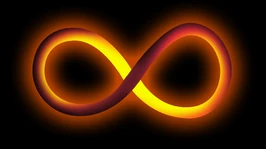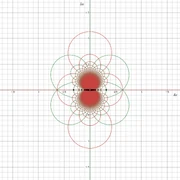
The lemniscate, the symbol commonly used to represent infinity.
“Infinity” is a term used for a concept that is, in a sense, larger than any natural number (however, it is not a natural number itself). Not all senses of infinity are “numbers” and those that are infinite numbers can alternatively be called transfinite numbers.
In calculus, a variable tends to infinity if it grows without bound, this infinity is signed when one works with real variables and when one works with complex variables, a variable tends to infinity if its absolute value grows without bound. In this context, infinity is not a number.
In set theory, cardinal numbers are used to specify the number of elements in a set and ordinals can be used to describe well-orders of sets. They are called “infinite” or “transfinite” if they are larger than any natural (finite) number.
A person who does not accept the idea of infinity is called a finitist.
Infinity in Analysis[]
Real analysis[]
Complex analysis[]

Contour plot of , showing the behaviour of around infinity. is said to have an essential singularity at because has an essential singularity at 0.
In complex analysis, a single point at infinity called complex infinity, often symbolised by or just , can be considered. The complex line with complex infinity is called the Riemann sphere or extended complex line. The behavior of a function as it approaches infinity is defined to be the behaviour of the function as it approaches 0.
Nonstandard analysis and Hyperreal Numbers[]
Infinite numbers in Set Theory[]
Infinite Cardinals[]
When defining infinite numbers by cardinality, it is possible to prove that there exist many different sizes of infinity. This means that it is impossible to produce a bijection between some pairs of infinite sets.
One such demonstration of this is the difference in size between the natural numbers and the real numbers. Consider a set of real numbers. Without loss of generality, we can limit these real numbers to be between 0 and 1, using a bijection like the function to use the full set. Suppose that a bijection exists between this set and the natural numbers, called . Now, there exists a real number for which the first digit of this real number is not the first digit of , and for which the second digit is not the second digit of , and in general for which the nth digit is not the nth digit of . Since this number is different to all , but is a bijection, this number is a real number that is not in the countable set we have, so the real numbers are not countable.
Generally, the smallest cardinal, equal to the cardinality of the natural numbers, is called , and in general the smallest cardinal greater than is . The cardinality of the powerset of the natural numbers is called , and in general the cardinality of the powerset of is . The continuum hypothesis (CH) holds that ; the generalized continuum hypothesis (GCH) additionally holds that for all n. Both the continuum hypothesis and its generalization are statements independent of Zermelo-Fraenkel set theory with the Axiom of Choice (ZFC), meaning that ZFC’s consistency is necessary and sufficent for the consistency of ZFC+GCH and its negation.
Furthermore, as an introduction to the concept of infinite ordinals & inaccessible cardinals; a mathematically valid demonstration of an order type/cardinal number exceeding that of . The second paragraph of this section is a paraphrasing of Cantor's diagonal argument, which states that a one-to-one correspondence of infinite sets to the infinite set of natural numbers is impossible. Therefore, as this process itself can be reproduced an infinite number of times - the resulting unique set itself being added to the "pool" of infinite sets - without fail, this means that a well-ordered infinite set exceeding that of must exist via the replacement axiom of ZFC set theory: its corresponding cardinal is .
Infinite Ordinals[]
Another way to enumerate infinities is to have them represent the order types of well-ordered infinite sets. The ordinal numbers are single sets that represent their corresponding order type; if a well-ordered set is order isomorphic to an ordinal , it is said to have order type .
The smallest infinite ordinal is , the order type of the natural numbers; defined to be equal to the set of natural numbers and well-ordered under the relation . Larger ordinals can be constructed by taking the successor of an existing ordinal via (this is also well-ordered under , but is not order isomorphic to ), or by taking the limit of an existing set of ordinals.
Many ordinals have the same cardinality; for example, there exists a bijection between and , so both have cardinality even though they are ordered differently.
Objects too large to be sets[]
In von Neumann–Bernays–Gödel (NBG) set theory and Morse–Kelley (MK) set theory, theories stronger than ZFC, the notion of a proper class, a collection "too large" to be a well-founded set, is formalized. The objects these theories talk about are called classes, all sets are classes but not all classes are sets. A class is a set if and only if there exists a class that contains as an element. A class is called proper if and only if there is no class that contains it as an element (proper classes cannot be elements of a class). For any given proper class, there exists a bijection between it and the class of ordinals .
In the Axiom System of Conglomerates (ACG), a theory stronger than MK and equivalent to MK+(there exists an inaccessible cardinal), the notions of conglomerates and secondclasses, generalizations of sets and classes, are formalized [1]. Conglomerates are well-founded objects that can contain other conglomerates. All classes, including proper classes, are conglomerates and can be contained by other conglomerates. Any collection of conglomerates is a secondclass and a secondclass is called a proper secondclass if and only if there is no conglomerate that contains . A conglomerate is called a proper conglomerate if and only if there is no class that contains . A conglomerate that satisfies all properties of an ordinal (but is not necessarily a set) is called an ordinal of type two. is an example of an ordinal of type two.
Infinite Surreal Numbers[]
The class of surreal numbers with the arithmetic operations are a proper class-sized totally ordered field which contains the set of real numbers, set of hyperreal numbers, and proper class of ordinal numbers as subclasses. A surreal number is called positive infinite if it satisfies for all real numbers . The additive inverse of a positive infinite can be called negative infinite and the multiplicative inverse of one can be called positive infinitesimal. All infinite surreals have a birthday greater than or equal to the ordinal .
Infinites in Physics[]
“Absolute Infinity”[]
Absolute infinity in 2 states, Mathematical absolute infinity and philosophical/Conceptual absolute infinity. Mathematical absolute infinity represents the highest point in mathematics, and philosophical absolute infinity represents something that can only be surpassed using logical paradoxes.
References[]
- ↑ Kongshi, Xu. Advances In Chinese Computer Science, Volume 3. World Scientific, March, 30, 1991.


































